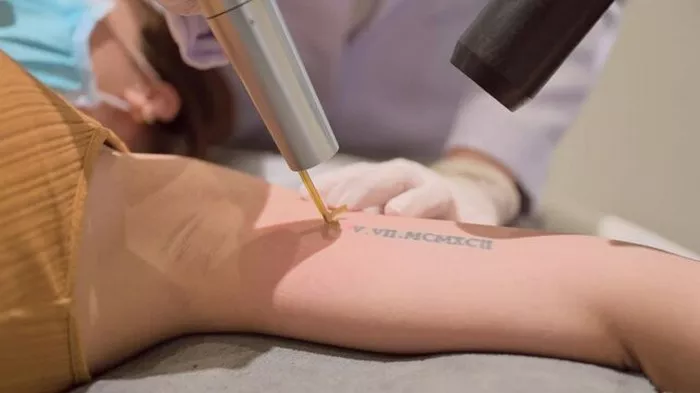Laser tattoo removal is a popular procedure for those looking to erase or lighten unwanted tattoos. However, timing is crucial to ensure the best results and minimize potential complications. This article delves into the recommended waiting period, the healing process of a new tattoo, factors affecting removal timing, risks of early removal, the importance of professional consultations, and aftercare instructions.
How Soon Can You Get Laser Tattoo Removal
The general advice for starting laser tattoo removal is to wait at least 6-8 weeks after getting a new tattoo. This waiting period allows the tattoo to heal sufficiently and ensures that the skin is in the best condition for the laser treatment.
Waiting for the recommended period is essential for several reasons:
Optimal Results: A fully healed tattoo responds better to laser treatment, leading to more effective removal with fewer sessions.
Avoiding Complications: Starting laser removal too soon can lead to complications such as skin irritation, infections, and scarring. The skin needs time to recover from the tattooing process before it can handle the laser treatment.
Healing Process
Healing Stages of a New Tattoo
Understanding the healing stages of a new tattoo is crucial to determine when it is safe to begin laser removal:
Initial Healing (Days 1-6): During the first few days, the tattooed area is an open wound. The body starts to form a protective layer of scabs, and redness and swelling are common.
Peeling and Flaking (Days 7-14): The scabs begin to flake off, and the skin may peel. This stage is similar to healing from a sunburn.
Continued Healing (Days 15-30): The outer layer of skin heals, but the deeper layers continue to recover. The tattoo might look dull or cloudy as the skin regenerates.
Complete Healing (Weeks 4-8): The skin has largely healed, though the deeper layers may still be repairing. The tattoo’s true appearance becomes more apparent.
Signs of a Fully Healed Tattoo
A tattoo is sufficiently healed and ready for removal when:
- The skin is no longer red or swollen.
- All scabs and peeling have resolved.
- The area feels smooth and normal to the touch.
- There is no oozing or bleeding from the tattoo site.
Factors Affecting Removal Timing
Size: Larger tattoos may take longer to heal due to the extensive area of skin affected.
Color: Different ink colors can affect the healing process and removal. For example, black and dark inks are generally easier to remove than lighter colors.
Location: Tattoos on areas with thicker skin (like the back) may heal faster than those on thinner, more delicate skin (like the wrists or ankles).
Skin Type and Overall Health
Skin Type: People with lighter skin tones often experience faster healing times and more effective laser removal. However, those with darker skin tones can also achieve good results with proper care.
Overall Health: A person’s general health and immune system function significantly impact the healing process. Healthy individuals typically heal faster and respond better to laser treatments.
Risks of Early Removal
Starting laser tattoo removal too soon can result in several complications:
Skin Irritation: The skin may react adversely to the laser, leading to increased irritation and inflammation.
Scarring: Early laser treatment on insufficiently healed skin can cause scarring, affecting the skin’s appearance and texture.
Incomplete Removal: The laser might not be able to break down the ink effectively if the skin has not fully healed, requiring more sessions and potentially leading to suboptimal results.
SEE ALSO: How Long Does a 3/4 Sleeve Tattoo Take
Consulting with a Professional
It is crucial to consult with a dermatologist or laser removal specialist before beginning the removal process. They can assess the tattoo and provide personalized advice based on its condition and your skin type.
Consulting a professional is essential for:
Assessing Tattoo Condition: A professional can determine whether the tattoo is fully healed and ready for laser removal.
Personalized Advice: They can offer guidance tailored to your specific situation, including the expected number of sessions and potential outcomes.
Safety Measures: Professionals ensure the procedure is carried out safely, minimizing risks and complications.
What to Expect During the Consultation
During the consultation, you can expect:
Evaluation of Tattoo: The specialist will examine the tattoo’s size, color, and location, as well as your skin type.
Medical History: You may need to provide information about your medical history and any underlying health conditions.
Discussion of Expectations: The specialist will discuss your goals for tattoo removal and set realistic expectations regarding the process and results.
Treatment Plan: A customized treatment plan will be created, outlining the recommended number of sessions and aftercare instructions.
Aftercare Instructions
Caring for Skin Between Sessions
Proper aftercare between laser removal sessions is vital to promote healing and achieve the best results:
Keep the Area Clean: Gently clean the treated area with mild soap and water to prevent infection.
Moisturize: Apply a fragrance-free moisturizer to keep the skin hydrated and promote healing.
Avoid Sun Exposure: Protect the treated area from direct sunlight by wearing protective clothing or using sunscreen with a high SPF.
Follow Instructions: Adhere to any specific aftercare instructions provided by your specialist.
Minimizing Discomfort and Promoting Healing
Cold Compresses: Apply cold compresses to reduce swelling and soothe the treated area.
Pain Relief: Over-the-counter pain relievers, such as ibuprofen, can help manage discomfort.
Hydration: Drink plenty of water to support overall skin health and healing.
Avoid Picking or Scratching: Refrain from picking or scratching the treated area to prevent scarring and infection.
Conclusion
Laser tattoo removal is a meticulous process that requires careful timing and professional guidance to ensure the best possible results. By adhering to the recommended waiting period, understanding the healing stages of a tattoo, considering factors that affect removal timing, and consulting with professionals, individuals can navigate the removal process safely and effectively. Proper aftercare between sessions is also crucial to promote healing and achieve optimal outcomes. Always prioritize professional advice and care to ensure a smooth and successful tattoo removal journey.
Related Topics

